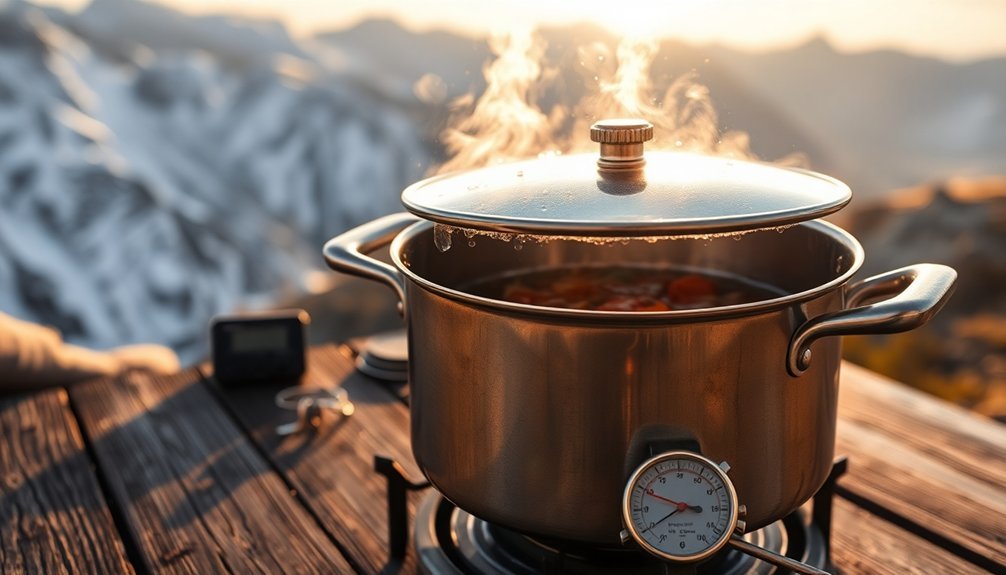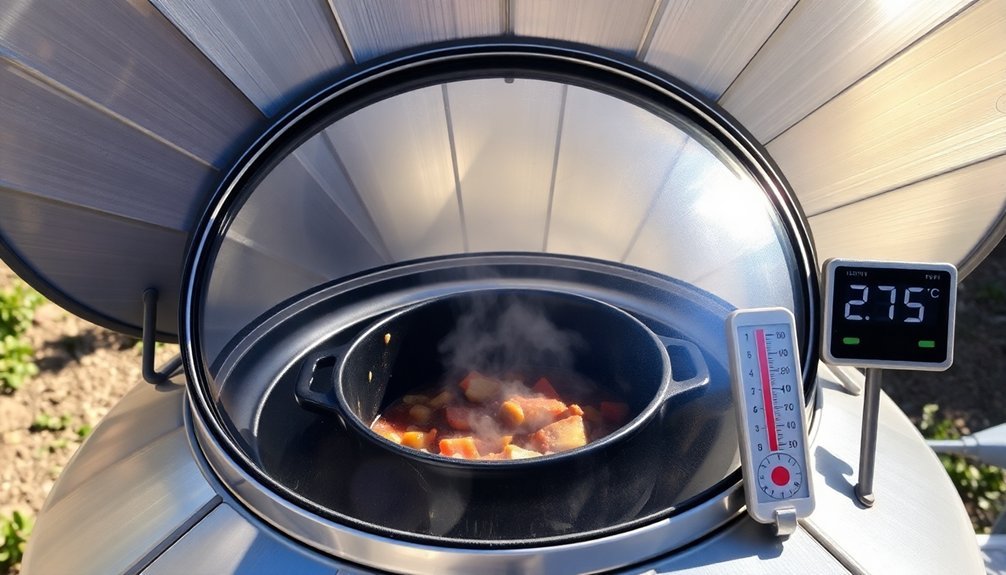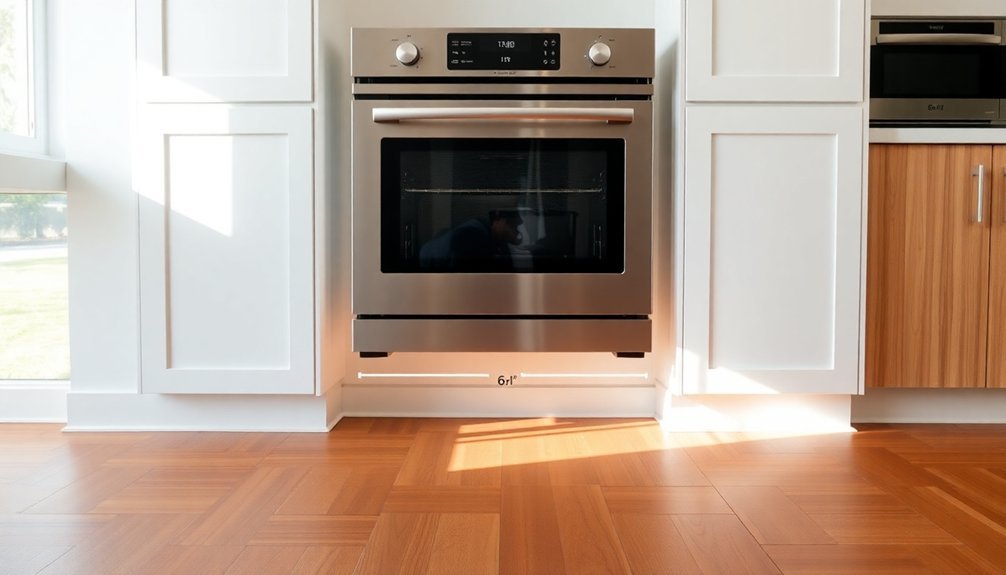When you're cooking at high altitudes, you'll need three key adjustments to succeed. First, increase your cooking time by 25% for moist heating methods like boiling and braising – a 2-hour roast now needs 2.5 hours. Second, remember that water boils at lower temperatures (dropping 0.9°F per 500 feet of elevation), so you'll need to extend cooking times for boiled items like eggs and potatoes. Third, combat moisture loss by starting with extra liquid and using tight-fitting lids, as high altitudes accelerate evaporation. These mountain-specific tweaks are just the beginning of mastering high-altitude culinary techniques.
Lengthening Your Cooking Duration

When cooking at high altitudes, you'll need to greatly adjust your timing to achieve properly cooked meals. Add 25% more time for moist heating methods like boiling, simmering, and braising. A roast that normally takes 2 hours at sea level will need about 2.5 hours at higher elevations.
You'll find that hard-cooked eggs, dried beans, and root vegetables require significant timing adjustments. For example, your "3-minute" egg might take 5 minutes at 5,000 feet. Oven roasting remains unaffected by altitude changes.
If you're using a slow cooker, make sure it maintains at least 200°F, as it'll simmer at lower temperatures in high altitudes. Instead of increasing heat, which can dry out your food, focus on extending cooking duration.
Always use a food thermometer to verify proper internal temperatures and keep pans tightly covered to retain moisture.
Water Boiling Point Changes
Understanding water's boiling point is essential for high-altitude cooking success. You'll notice that water boils at lower temperatures as you climb higher, which greatly impacts your cooking results. At sea level, water boils at 212°F, but for every 500 feet you ascend, the boiling point drops by 0.9°F. Charles Darwin himself experienced that food remained undercooked during his high-altitude explorations.
| Altitude (feet) | Boiling Point |
|---|---|
| Sea Level | 212°F (100°C) |
| 2,000 | 208°F (98°C) |
| 10,000 | 193.6°F (89.8°C) |
This change occurs because atmospheric pressure decreases at higher elevations, affecting how heat transfers to your food. You'll need to adjust cooking times and methods accordingly. For example, if you're making hard-boiled eggs or cooking potatoes, you'll need to extend your cooking duration. Consider using a pressure cooker to compensate for these lower boiling points and achieve better results.
Moisture Control Methods

Successfully managing moisture at high altitudes requires specific techniques to prevent food from drying out prematurely.
You'll need to increase your cooking time by up to 25% for moist heating methods, though this doesn't apply to oven-roasted meats. For example, if a dish takes 2 hours at sea level, plan for 2½ hours at elevation.
High humidity levels can actually work to your advantage by slowing down moisture evaporation during the cooking process.
Start with extra liquid in your soups, stews, and grain dishes, as water evaporates more quickly at altitude.
Keep hot water nearby to add as needed – you might need up to twice the usual amount. Always use tight-fitting lids to trap moisture while cooking, especially when braising or simmering.
Don't increase heat to compensate for longer cooking times, as this will only speed up evaporation. Instead, lower your frying temperature by 3 degrees F per 1,000 feet elevation.
Frequently Asked Questions
Do Altitude Changes Affect Microwave Cooking Times and Power Settings?
Yes, you'll need longer cooking times at high altitudes since microwaves heat less efficiently there. You should increase cooking duration by 1-3 minutes and may need to adjust power settings for better results.
How Does High Altitude Impact the Shelf Life of Baked Goods?
You'll notice your baked goods spoil faster at high altitudes due to quicker moisture loss, accelerated chemical reactions, and structural changes from over-rising. They'll become stale sooner unless you use proper storage methods.
Should Yeast Quantities Be Adjusted Differently Than Chemical Leavening Agents?
Yes, you'll need to handle yeast and chemical leaveners differently. While you should reduce yeast by 20-25% and adjust proofing times, you'll want to decrease chemical leaveners by smaller, more precise measurements.
Does Altitude Affect Marination Times for Meats and Vegetables?
You don't need to adjust marination times based on altitude. While altitude affects cooking times and moisture levels, there's no direct evidence that it impacts how quickly marinades penetrate meats and vegetables.
Can Pressure Canner Processing Times Remain the Same at High Altitudes?
Yes, you don't need to adjust pressure canner processing times at high altitudes. You'll only need to increase the pressure level to compensate for lower atmospheric pressure, while keeping the processing duration the same.
In Summary
You'll find high-altitude cooking requires careful attention to these adjustments. Remember to add 15-25% more time for most recipes, account for water's lower boiling point by increasing liquid temperatures, and control moisture loss through proper covering and humidity management. By applying these three key principles, you'll transform challenging mountain cooking conditions into consistently successful meals at any elevation.





Leave a Reply